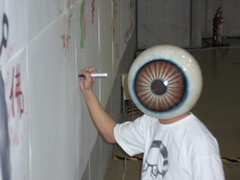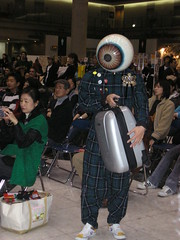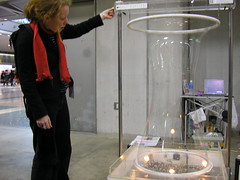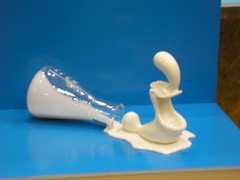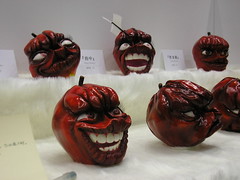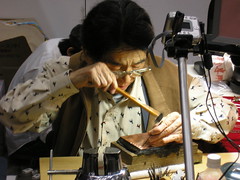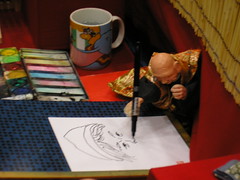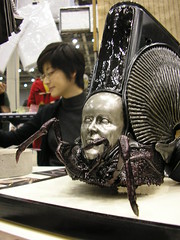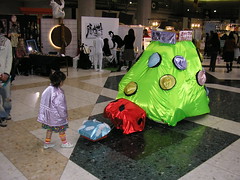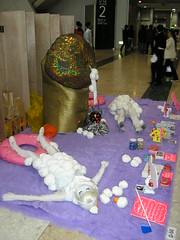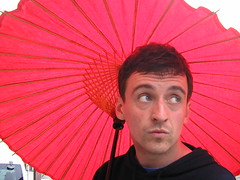The annual Halloween parade is probably the biggest event in Kawasaki apart from the Cock Festival. Be-costumed freaks and Techno in the streets was the order of the day.
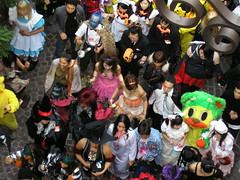
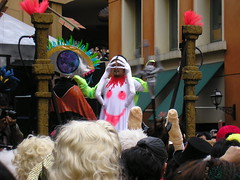
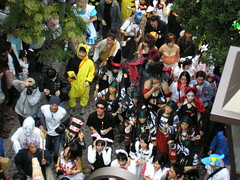
Some of the effort put in was astounding...
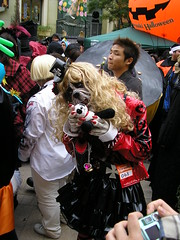
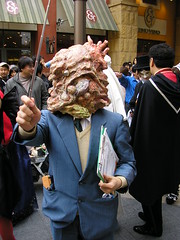
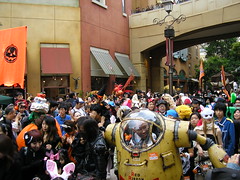
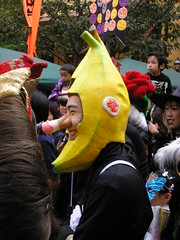
...as was the turnout...
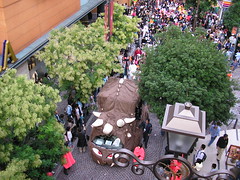
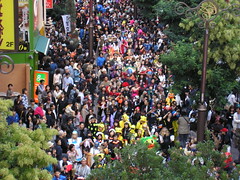
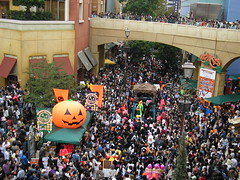
...complete with band...
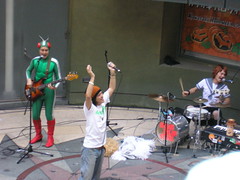
...and those who are just too cool for school...
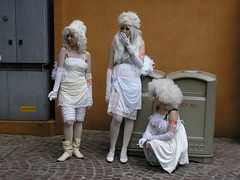
The costumes were judged by a panel of similarly festooned characters, presided over by a bear in a pumpkin.
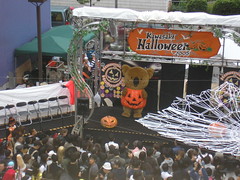
We didn`t see the individual winners, but the group category award was picked up by a collective of traditional Japanese beasties, the most notable of whom was a young lady dressed as a Kappa.
Kappas are water demons, resembling a turtle that walks on two legs, complete with beak, bird feet and a dish of water on its head that gives the creature supernatural powers & weakens it should it spill. Kappas like cucumbers, Sumo Wrestling and removing peoples intestines through their anuses.
I read a story about a Kappa and a Priest in a book of tales translated for Victorian children (I`m sure the original versions wouldn`t have described every other garment as "quaint"). On his pilgramage, the Priest comes a cropper with a Kappa. Thankfully he has a number of cucumbers in his pouch, so he manages to satisfy the creature enough to earn its mercy & hear its story. Apparently, the only reason the Kappa pulls peoples guts out through their arses is because it wishes to be a human, and resents people for being what it desires. To top it all off, the Kappa is immensely sad and lonely. As befits a Buddhist, the Priest tactfully points out that if the Kappa didn`t kill people it would probably have more friends and it would stand a good chance of being reborn as a human. The Kappa has a sulk at this and the Priest goes on his way. Years later, after thinking about what was said to him, the Kappa decides to visit the local village he has been terrorising in an effort to make peace. Unfortunately, countless rectal eviscerations have left the villagers a little sceptical, so they stone the fellow to death. The Kappa didn`t put up any resistance, and once the deed was done, the villagers felt remorseful and built a shrine in his memory. This shrine is later visited by the Priest, who hears the villagers story. Although he is sad that the Kappa died in such a manner, he is happy that it will probably be reincarnated as a human.
"The Japanese ghost is a thing of the summer..." writes the appropriately named Tim Screech. Whilst Western ghosts are invoked through an already creepy atmosphere, the abandoned house, the creaky stair, Japanese ghosts are of "...the tangled bedclothes or the broken fan...spawned of steamy weather, squeezed out, as if in some fetid moment from other things."
The Japanese word for Ghost, Obake, literally means "changing thing". Everyday, routine objects are capable of breeding Obake. Recent
Japanese Horror films such as
Ringu and
One Missed Call describe such haunted objects, a video and mobile phone. (Funnily enough, a great many of these films have been remade by Hollywood, although if the American rendition of
The Ring is anything to go by, I suggest you check out the originals. Japanese horror is a much subtler fish, relying on a slight shift in the mood of the mundane, rather than a CGI onslaught of teeth, roaring and gore)
These changes in everyday objects can be harmless or amusing, like an umbrella Obake, in possesion of one eye, a rolling tongue and a foot for hopping, but others are far more sinister...
In the Tokaido Yotsuya Kaidan (ghost story of Tokaido Yotsuya) an unfaithful samurai poisons his sick wife, Oiwa, over an affair fabricated to save his reputation. Administered as a medicine, the poison disfigures her horribly and kills her pretty much instantly. The Samurai goes to tell his mistress what has happened, when he is greeted by his dead wife in the street. Panicking, he beheads her, only to discover that he has actually beheaded his mistress. In a state of shock, he runs to his mistresses father, only to be met by his dead wife again. He draws his sword and strikes her down, only to discover he has killed his mistresses father. He flees to a shack in the mountains, where he is tormented by images of Oiwa coming from lanterns or the fire, until he goes mad and kills himself.
The scary thing about Obake is that they, like Ghosts, turn our perceptions of the world upside down.
Damnable phenomena like these illustrate that our world isn`t as solid and immutable as we like to think it is.
Although Obake can refer to anything that is just a little bit strange, they can be roughly split into three categories.
Oni, Demons or Ogres are probablythe most solid, famously guarding the various Buddhist Hells or being vanquished by
sundry folk heroes. Yokai comprise all manner of weird beasties, including the Kappa, Mount Kuramas` Tengu and the Rokurokubi, a female monster with a very long and flexible neck, otherwise indistinguishable from other women. Then there`s the Yurei, amongst whom Oiwa and The Rings` Sadako might be counted. According to Shinto beliefs, all people are endowed with a soul or Reikon. Should a person die in an unexpected or emotional state, the Reikon stays behind, as if it had more work to do, whether it`s revenge, setting a reputation straight or receiving a proper burial. Sound familiar? Another feature of Yurei is their absence of legs. Like the Western Ghost, they float, unnconnected from but still present in the world. It`s interesting that two non-existent phenomena from opposite ends of the planet should have such features in common.
Hearty cap-doffing to Tim Screech, Professor of Japanese Art History at the School of Oriental and African Studies, University of London for his
really interesting article that formed the bulk of this entry. Points I have tried to raise above are better made therein.
Labels: cool places, culture (shock), folklore, fun, I wasn't expecting that, Japan, tourists

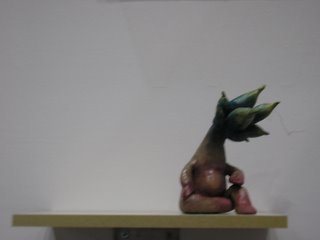
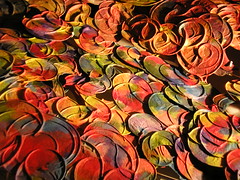
 For those of you as perplexed as I, their website might provide some invaluable insights...but then again, it may not.
For those of you as perplexed as I, their website might provide some invaluable insights...but then again, it may not. 